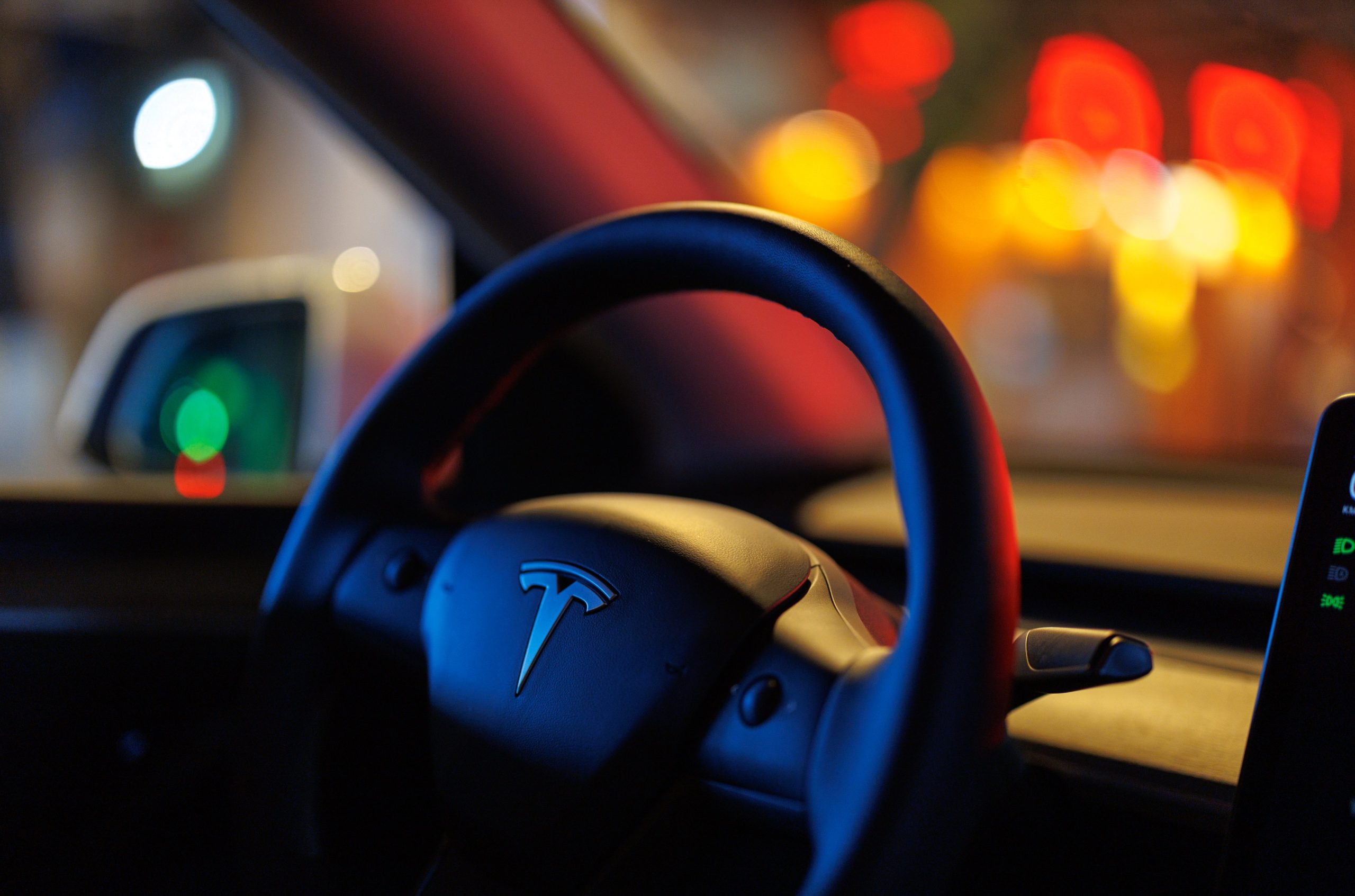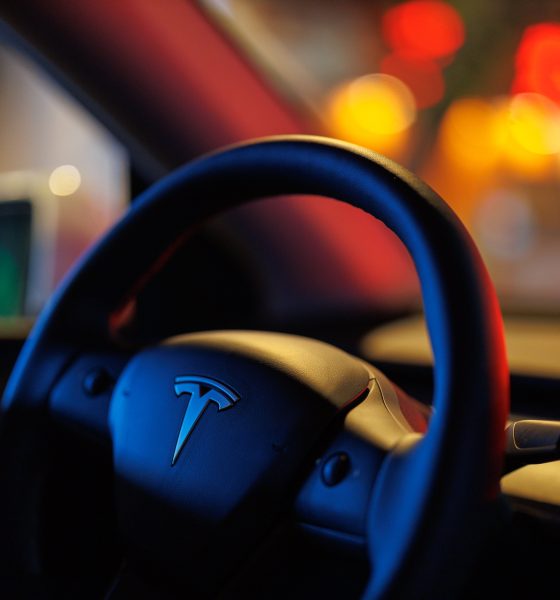Tesla has called on the Biden administration to enact stricter fuel efficiency standards through 2032 than those recently proposed by U.S. regulators.
In July, the National Highway Traffic Safety Administration (NHTSA) proposed increasing the Corporate Average Fuel Economy (CAFE) requirements for cars by 2 percent and by 4 percent for trucks and SUVs annually between 2027 and 2032. The proposal was challenged by the Alliance for Automotive Innovation, which said that the move “exceeds maximum feasibility.”
Now, Tesla has responded by requesting that the White House increase the efficiency standards annually by 6 percent for cars and 8 percent for trucks and SUVs between 2027 and 2032, according to a report from Reuters. Tesla says enacting the stricter proposal would “conserve energy and address climate change.”
The result of the NHTSA’s original proposal would establish an average fleet-wide fuel efficiency of 58 miles (93 km) per gallon by 2032. The news also comes as many traditional automakers face difficulty in switching their entire lineups to fully electric models, although Tesla only produces and sells fully electric vehicles.
On Monday, an automotive group that represents General Motors (GM), Toyota, Volkswagen and most other major automakers shared harsh criticism of the NHTSA’s proposal, saying that it wasn’t reasonable and requires several revisions.
In a separate response, the American Automotive Policy Council, which represents Ford, GM and Chrysler’s parent company Stellantis, pushed the NHTSA to cut its proposed increases in half to just 2 percent for trucks and SUVs. In the statement, the council said the NHTSA’s original proposal “would disproportionately impact the truck fleet.”
Additionally, the group pointed out that roughly 83 percent of all vehicles produced by Ford, GM and Stellantis are trucks.
The NHTSA responded by saying the proposed rule “is focused on saving Americans money at the gas pump and strengthening American energy independence.” The agency expects the proposal to have combined benefits exceeding costs by over $18 billion.
Last month, the Alliance for Automotive Innovation said automakers would be held responsible for over $14 billion in non-compliance penalties between 2027 and 2032 under the current rules.
In response to the NHTSA proposal, Toyota said on Tuesday that the fines were “proof that there is insufficient technology to meet the proposed standards and that such standards have been set beyond maximum feasible.”
In separate projections, automakers GM, Stellantis and Ford have estimated that the NHTSA’s proposal would cost them $6.5 billion, $3.1 billion and $1 billion, respectively.
The automakers have also fought against the U.S. Energy Department’s proposal to make large revisions to how petroleum-equivalent fuel economy is calculated in the CAFE program, adding that doing so could “devalue the fuel economy of electric vehicles (EVs) by 72 percent.”
This is not the first time Tesla has encouraged federal agencies to take proposed fuel economy standards even further. In June, Tesla stated that the Environmental Protection Agency’s (EPA’s) emission limits on heavy-duty trucks, proposed in April, didn’t go far enough in encouraging the U.S. to electrify larger vehicles.
The United Auto Workers (UAW) union, representing Ford, GM and Stellantis, asked President Biden in July to reconsider proposed fuel economy standards, deeming them unfeasible.
What are your thoughts? Let me know at zach@teslarati.com, find me on X at @zacharyvisconti, or send your tips to us at tips@teslarati.com.

News
Tesla starts showing how FSD will change lives in Europe
Local officials tested the system on narrow country roads and were impressed by FSD’s smooth, human-like driving, with some calling the service a game-changer for everyday life in areas that are far from urban centers.

Tesla has launched Europe’s first public shuttle service using Full Self-Driving (Supervised) in the rural Eifelkreis Bitburg-Prüm region of Germany, demonstrating how the technology can restore independence and mobility for people who struggle with limited transport options.
Local officials tested the system on narrow country roads and were impressed by FSD’s smooth, human-like driving, with some calling the service a game-changer for everyday life in areas that are far from urban centers.
Officials see real impact on rural residents
Arzfeld Mayor Johannes Kuhl and District Administrator Andreas Kruppert personally tested the Tesla shuttle service. This allowed them to see just how well FSD navigated winding lanes and rural roads confidently. Kruppert said, “Autonomous driving sounds like science fiction to many, but we simply see here that it works totally well in rural regions too.” Kuhl, for his part, also noted that FSD “feels like a very experienced driver.”
The pilot complements the area’s “Citizen Bus” program, which provides on-demand rides for elderly residents who can no longer drive themselves. Tesla Europe shared a video of a demonstration of the service, highlighting how FSD gives people their freedom back, even in places where public transport is not as prevalent.
What the Ministry for Economic Affairs and Transport says
Rhineland-Palatinate’s Minister Daniela Schmitt supported the project, praising the collaboration that made this “first of its kind in Europe” possible. As per the ministry, the rural rollout for the service shows FSD’s potential beyond major cities, and it delivers tangible benefits like grocery runs, doctor visits, and social connections for isolated residents.
“Reliable and flexible mobility is especially vital in rural areas. With the launch of a shuttle service using self-driving vehicles (FSD supervised) by Tesla in the Eifelkreis Bitburg-Prüm, an innovative pilot project is now getting underway that complements local community bus services. It is the first project of its kind in Europe.
“The result is a real gain for rural mobility: greater accessibility, more flexibility and tangible benefits for everyday life. A strong signal for innovation, cooperation and future-oriented mobility beyond urban centers,” the ministry wrote in a LinkedIn post.
News
Tesla China quietly posts Robotaxi-related job listing
Tesla China is currently seeking a Low Voltage Electrical Engineer to work on circuit board design for the company’s autonomous vehicles.

Tesla has posted a new job listing in Shanghai explicitly tied to its Robotaxi program, fueling speculation that the company is preparing to launch its dedicated autonomous ride-hailing service in China.
As noted in the listing, Tesla China is currently seeking a Low Voltage Electrical Engineer to work on circuit board design for the company’s autonomous vehicles.
Robotaxi-specific role
The listing, which was shared on social media platform X by industry watcher @tslaming, suggested that Tesla China is looking to fill the role urgently. The job listing itself specifically mentions that the person hired for the role will be working on the Low Voltage Hardware team, which would design the circuit boards that would serve as the nervous system of the Robotaxi.
Key tasks for the role, as indicated in the job listing, include collaboration with PCB layout, firmware, mechanical, program management, and validation teams, among other responsibilities. The role is based in Shanghai.
China Robotaxi launch
China represents a massive potential market for robotaxis, with its dense urban centers and supportive policies in select cities. Tesla has limited permission to roll out FSD in the country, though despite this, its vehicles have been hailed as among the best in the market when it comes to autonomous features. So far, at least, it appears that China supports Tesla’s FSD and Robotaxi rollout.
This was hinted at in November, when Tesla brought the Cybercab to the 8th China International Import Expo (CIIE) in Shanghai, marking the first time that the autonomous two-seater was brought to the Asia-Pacific region. The vehicle, despite not having a release date in China, received a significant amount of interest among the event’s attendees.
Elon Musk
Elon Musk and Tesla AI Director share insights after empty driver seat Robotaxi rides
The executives’ unoccupied tests hint at the rapid progress of Tesla’s unsupervised Robotaxi efforts.

Tesla CEO Elon Musk and AI Director Ashok Elluswamy celebrated Christmas Eve by sharing personal experiences with Robotaxi vehicles that had no safety monitor or occupant in the driver’s seat. Musk described the system’s “perfect driving” around Austin, while Elluswamy posted video from the back seat, calling it “an amazing experience.”
The executives’ unoccupied tests hint at the rapid progress of Tesla’s unsupervised Robotaxi efforts.
Elon and Ashok’s firsthand Robotaxi insights
Prior to Musk and the Tesla AI Director’s posts, sightings of unmanned Teslas navigating public roads were widely shared on social media. One such vehicle was spotted in Austin, Texas, which Elon Musk acknowleged by stating that “Testing is underway with no occupants in the car.”
Based on his Christmas Eve post, Musk seemed to have tested an unmanned Tesla himself. “A Tesla with no safety monitor in the car and me sitting in the passenger seat took me all around Austin on Sunday with perfect driving,” Musk wrote in his post.
Elluswamy responded with a 2-minute video showing himself in the rear of an unmanned Tesla. The video featured the vehicle’s empty front seats, as well as its smooth handling through real-world traffic. He captioned his video with the words, “It’s an amazing experience!”
Towards Unsupervised operations
During an xAI Hackathon earlier this month, Elon Musk mentioned that Tesla owed be removing Safety Monitors from its Robotaxis in Austin in just three weeks. “Unsupervised is pretty much solved at this point. So there will be Tesla Robotaxis operating in Austin with no one in them. Not even anyone in the passenger seat in about three weeks,” he said. Musk echoed similar estimates at the 2025 Annual Shareholder Meeting and the Q3 2025 earnings call.
Considering the insights that were posted Musk and Elluswamy, it does appear that Tesla is working hard towards operating its Robotaxis with no safety monitors. This is quite impressive considering that the service was launched just earlier this year.










